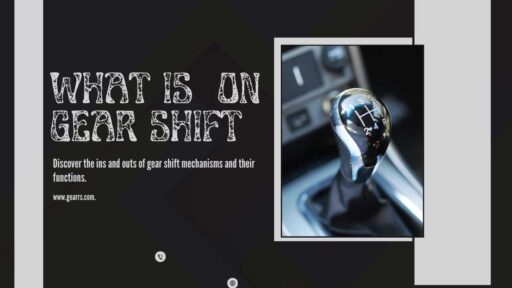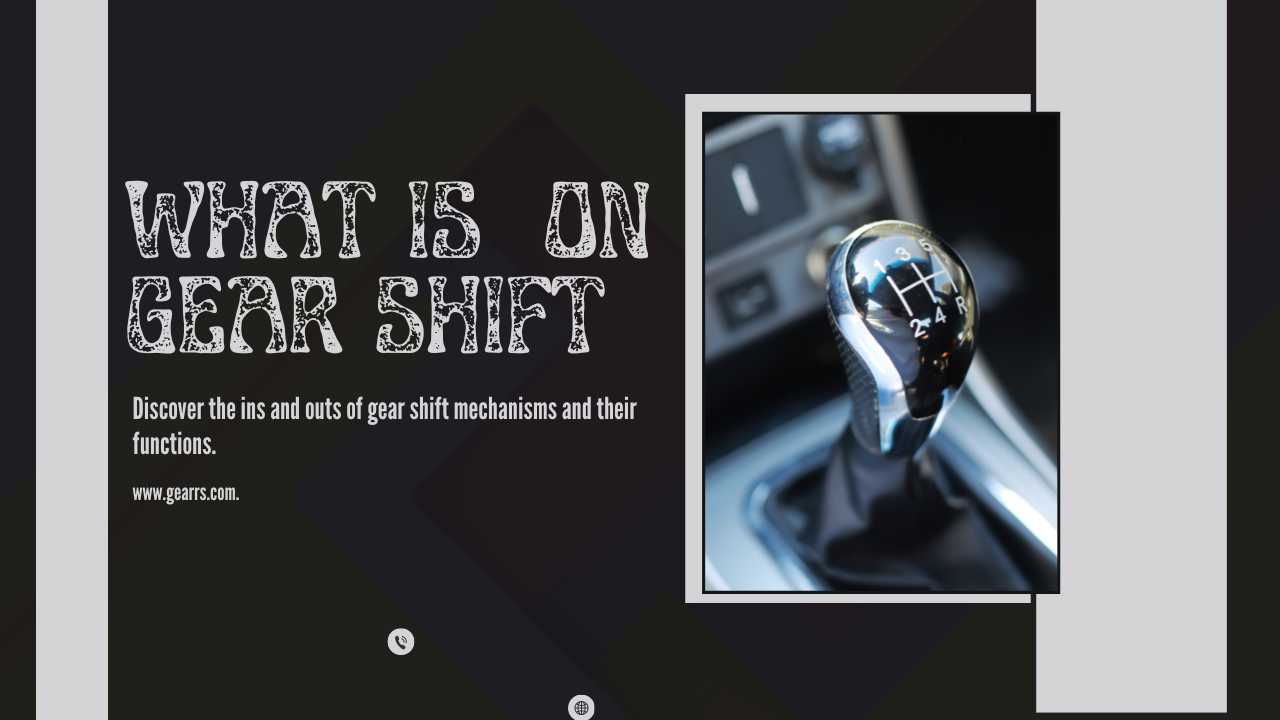For a lot of people, driving is now more than just being transported from one place to another. One thing about driving, though, is that most car enthusiasts or even DIY mechanics out there learn how to use What Is S On Gear Shift. Knowing this part is crucial.
It will make your drive amazing, whether you love the complexity of a manual gearbox or the simplicity of an automatic one. This article aims to explain what gear oil in a car does. It will also look at their function, common defects, and how to maintain them.
Explaining Different Gear Positions
But first, before we go into detail concerning ‘S’ mode, let’s understand several ways in which gears shift positions on various cars. Below are some typical What Is S On Gear Shift positions:
- P – This position locks the transmission so that it cannot move. It should be used when the vehicle is not moving.
- R – This position allows the car to go backward only. You utilize it when you want to reverse your car.
- N – In neutral, power from an engine is cut off from the wheels by disengaging clutch plates which change gears and allow free rolling of the car without starting the engine and pushing or towing.
- D: Under normal conditions for driving this position permits smooth shifting through all gears automatically optimizing gas efficiency and performance.
Now that we’ve covered some basics, let’s take a look at “S” mode on your gearshift.
Credit: Helpful DIY
Types of Car Gears
What Is S On Gear Shift refer to any changes in the transmission that enable power transfer between engines and wheels. There are two main types:
Manual Transmission
Manual Transmission (MT), also referred to as stick-shift, makes driver change their gears without any involvement from an external control unit; this works like a clutch pedal that breaks communication between engine and gear-box allowing the driver to select gears via gearstick matching engine speed for smooth transfer of powerful energy.
How it Works
When the driver presses down on the clutch pedal he/she disconnects the engine from the transmission and is then able to change gears. Gradually letting go of the clutch pedal reconnects the engine with the transmission. This kind of driving requires good timing and knowledge of how your engine runs, therefore it is more dynamic.
Advantages & Disadvantages
Pros
- More control over power delivery
- Tows better climbs steeper hills with less strain
- Manual transmissions tend to be more fuel-efficient than automatics if you know how to drive them right.
- Cons
- Physically tasking, especially in stop-and-go traffic
- Has a steep learning curve, which can intimidate beginners.
- Modern automatics are closing the fuel efficiency and performance gaps
Automatic Transmission
They are called AT (for short) because they can choose what gear ratio should be used without human intervention. This system has a set of complex planetary gear mechanisms that can infinitely vary according to speed and load conditions through hydraulic torque converter-controlled shifting.
How It Works Is Explained In The Following Way:
Automatic transmissions throw gears as a result of hydraulic pressure that responds to driver’s inputs, RPMs from an engine or vehicle velocity. An automatic transmission unlike manual one does this by using bands and clutches located within its housing instead of manually engaging gears.
Benefits and Disadvantages
Advantages
- For use in congested cities, easy drive.
- Less attention from the driver’s side.
- It helps when multitasking around.
- Disadvantages
- Complexity and slipping torque converter lead to lower fuel mileage.
- Limited control over gear selection.
- Higher repair costs than manuals.
- What Does the “S” Stand For on Your Gear Shift?
Many modern cars have an extra setting on their gear shift: S. Typically represented by an S or +/– sign. In “S,” when you put your car, it modifies when your transmission shifts, which enables a sportier driving experience.
Understanding the “S” on Your Gear Stick
You may be wondering what the “S” in “S” mode stands for. In fact, it is not “sports” as everyone might think. It actually means Sequential or Sequential Shift mode instead. In this case, a driver is allowed by the gearbox to change gears manually using either paddle shifters situated on his steering wheel or via a gear shift leveler giving more power over acceleration & deceleration; similar to that of manual transmissions.
Benefits of Using the “S” Mode
Now that we know what s mode means, let us look at its benefits. Here are some ways using s mode can make your driving better:
- More Control: Manually shifting gears lets you control how fast your car speeds up and slows down in relation to road conditions and personal preferences.
- Quick Gear Changes: Driving aggressively in s mode leads to quicker gear changes, which improves response. This is important when overtaking or driving on roads with many turns.
- Engine Braking: The most effective way of slowing down in gear S is compared to other gears. As an example, downshifting makes use of engine braking which results into less wear on brakes.
When to Use the “S” Mode
Now that you know the meaning of s mode, you are probably wondering when it is best used. So, here are a few situations where engaging s mode will be helpful:
- Sporty Driving: If you enjoy a more spirited driving experience, the “S” mode is perfect for you. It allows you to shift gears manually and makes you feel in control.
- Hilly Terrain: When driving on hilly or mountainous terrain, the “S” mode can help you maintain a consistent speed while descending steep slopes. Downshifting can provide engine braking without much use of the brake pads.
- Towing: For hauling trailers or carrying heavy cargo, using the “S” mode gives better handling and prevents frequent gear shifting.
Common Misconceptions About the “S” Mode
There are several misconceptions about what “s” stands for in “s” gear position that I would like to clarify:
- Fuel Efficiency: Contrary to popular belief; putting your car on ‘’s’’ does not mean low fuel consumption always. Even when on “S” mode, an automobile’s modern engine management systems optimize consumption of fuel.
- Engine Damage: Some people think that shifting gears manually in ‘’s’’ causes harm to your engine and transmission, but do not worry because this is just meant to keep bad things from your car’s way. Nonetheless, always adhere to the manufacturer’s advice and avoid over-revving or downshifting at high speeds.
Maintenance Tips for Gear Shifts
To extend the life of your car’s transmission and avoid problems, some regular upkeep is required. Here are a few things you should do to keep your What Is S On Gear Shift healthy:
Routine Maintenance
Keep an eye on the recommended frequency for changing transmission fluid as provided by the manufacturer of the vehicle.
- Change the clutch in order to maintain appropriate pressure and tension
- Check all linkage clips and make sure they are properly adjusted.
- D.I.Y. Checks and When to Seek Professional Help
- Leakages underneath your car could mean trouble with the transmission fluid.
- Gears may be difficult to find or too loose during shift changes in such vehicles implying that there is something wrong with them.
- A person should consult a trained mechanic if any of these common problems noted above happen or when he/she needs normal transmission service.
Common Gear Shift Problems and Solutions
Well-maintained transmissions usually change gears smoothly, but there are situations where some complications may arise that one needs to know how to handle so as not to lose his/her ability to drive his/her vehicle.
Shifting Difficulties
- Causes
- Worn-out/damaged parts of a clutch in case it is a manual gearbox.
- Automatics with liquids or pressure issues.
- Incorrectly adjusted cables/linkage.
Troubleshooting Tips
In many cases involving manual transmissions, these issues are related to synchro’s or clutches, which provide smooth shifting gears by making engine and wheel rotations synchronize with each other. A bad shift solenoid or sensor can result in shifting problems for automatic cars. On both types of transmissions, you must inspect the clutch and check the level of trans fluid.[1]
Grinding or Unusual Noises
Diagnostic Steps
- Can you identify where the noise comes from – the engine bay, the transmission itself, or within the driveshaft?
- When does it occur: during gear changes, under load, idle?
- Is there any connection between speed/noise or RPM/noise?
Potential Fixes
If a particular gear makes this sound, its synchro may be gone.
However, if you do not hear any distinct gears grinding, this is a good reason for you to carry out a full inspection of both your transmission system and clutch so as to better detect it.[2]
Other Gear Shift Modes to Be Aware Of
Besides “S,” there are other gear shift modes:
- Eco Mode: It modifies gearbox and engine settings in order to improve fuel economy. This mode is suitable for everyday driving and can help reduce the amount of fuel used during such trips.
- Snow Mode: Designed for driving safely when there is snow. The program alters the transmission settings as well as traction control systems in order to provide better handling capabilities for drivers.
- Manual Mode: Some cars have a feature called manual mode, which usually comes with either “M” or another gate on the gearshift. In this mode, you can shift like you would in “S.”
Frequently Asked Questions
Can I use the “S” mode in all driving conditions?
Though it can enhance your driving experience, the “S” mode may not be applicable in all road situations; thus, using it correctly will yield more results during such moments.
Will using the “S” mode wear out my transmission faster?
So long as the “S” mode is used in a responsible manner and strictly within the limits of the manufacturer, there would be less wear on your transmission. Remember, though, for longevity, you need to follow service schedules.
Can I change between “S” mode and “D” mode while driving?
With most vehicles, this is possible even when they are moving. However, it should not occur when the vehicle is subjected to violent acceleration or deceleration.
Conclusion of What Is S On Gear Shift
“S” written on your what is s on gear shift lever does not stand for nothing; rather it stands for Sequential or Sequential Shift, which means manual gear changing. For one to maximize this mode, one should know why and what benefits it has been created to serve him. Be advised that it was deliberately designed so that one can utilize it based on legitimate traffic rules.
Therefore, whenever you come across ‘s’ on your shift lever, take control of your vehicle and experience rapid speed what is s on gear shift. Drive safely!
CTA: Next time you drive out just switch only to S-mode and enjoy thrilling sensation of manual gear change . Also bear in mind those good habits of safe driving plus listen to manufacturers’ advice concerning their cars all the best!






